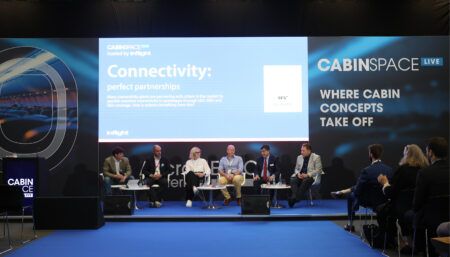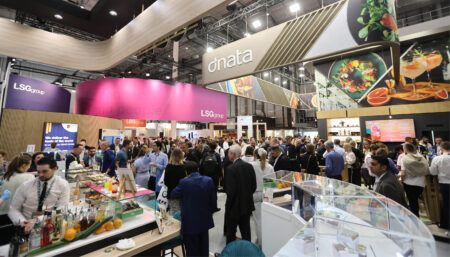Ahead of the Aircraft Cabin Innovation Summit USA, Monica Wick, CEO of RedCabin, discusses the event and industry trends.
What key facts should people know about the upcoming Aircraft Cabin Innovation Summit USA?
RedCabin’s mission is to encourage individuals to “collaborate to innovate”. The Aircraft Cabin Innovation Summit (ACIS) was created to bring the aircraft cabin passenger experience industry together in the firm belief that innovation is created through the opportunity to work together. Our events break down industry silos, enabling people to debate and discuss challenges and opportunities in a supportive environment.
Our summits are also an opportunity to hear from recognised industry experts, who share successful collaboration experiences. Recent examples are collaborations between Hawaiian and Adient Aerospace, ACLA and Sekisui Kydex, and many more. RedCabin summits have also become recognised as a platform where new cabin innovations are introduced.
The next ACIS is hosted by Teague in Everett, Washington, on 12-14 September, and offers the chance for people to work together in small groups to drive the next generation of innovation into the aircraft cabin, as well as meeting and hearing from inspirational leaders in the industry. One highlight of the September summit will be ANA speaking about the launch of its newest airline subsidiary, Air Japan.
What topics will be covered at the summit?
This summit is wholly focused on how the airline industry can enhance the passenger experience. We have speakers from leading US and Asian airlines, highlighting innovation in the cabin. Speakers and break-out sessions will also cover critical industry issues such as sustainability, the impact of new technologies such as artificial intelligence (AI) and accessibility in the cabin.
The summit will also be looking at the cabin of the future. For the first time, we will look at the opportunities driven by the eVTOL industry and how this might impact aircraft interiors in the future. Examples of collaboration between industry leaders such as Airbus and Air Transat will also be part of the packed agenda.
Are there networking events planned?
Absolutely. One of the many benefits for attendees at RedCabin summits is the number of opportunities to network. Attendance numbers are deliberately limited to ensure everyone has the chance to meet and get to know others in the industry. We also host a registration networking event at the start of the summit so delegates can spend time with their industry peers. It is incredible how often people mention how a collaboration between businesses started with a conversation at a RedCabin summit. Unlike a typical tradeshow format, our teams also create dedicated time slots across all three days for delegates to network with speakers, trusted partners and exhibitors. Additionally, at the end of day one, we host an evening networking reception.
What insights emerged from your European edition earlier in the year?
The European summit was held in March at Airbus’ incredible facility in Hamburg, Germany. This was our most popular summit to date, attended by around 250 industry leaders.
As well as showcasing recent cabin innovation from American Airlines and Starlux, the summit addressed some of the most relevant issues for the industry in the post-pandemic era. This included issues around air quality on board, as well as how antimicrobial and antiviral materials can be integrated into aircraft cabins. It also discussed the challenges that airlines face around delivering a consistent brand across multiple aircraft and how best to make the choice between creating a new cabin experience and refurbishment.
Highlights from the summit included a showcase on designing a new airline and launching it during the pandemic (Starlux), as well as highlighting a pioneering collaboration between PriestmanGoode, Lufthansa and Collins.
Many of the conversations at the European summit addressed the sustainability agenda, and how the industry can collaborate to create greener and more economical products for cabin interiors. One example was the development of a collaboration between a leading airframe manufacturer and Circularise to ensure traceability within the industry supply chain.
What are the key findings from your research on passenger experience and trends in the aviation industry?
At the end of each summit, we survey attendees – to take the pulse of the industry around key issues. After the March summit, we asked the industry leaders attending about the issues they felt most relevant to them. The two key areas to address were hygiene and sustainability.
The industry has taken huge strides in recent years on both these issues. New cleaning regimes and antiviral materials are already being rolled out in aircraft cabins. Additionally, the industry has advanced to ensure cabin air is cleaned more quickly and effectively, with innovative new ways to direct cabin airflow, reducing the amount of shared air between passengers.
With young generations travelling more, the topic of sustainability has become pivotal. As robust lightweight materials continue to be developed, the industry has reduced cabin interior weights, leading to a consequent reduction in fuel burn. Even something as simple as asking passengers to order food and beverage before the flight reduces weight and waste. There is still a long way to go but the industry is truly embracing these dual challenges.
What did the research reveal as the biggest areas in need of innovation?
Inside the traditional cabin structure, comfort and privacy are the two key areas that executives at RedCabin identified for innovation. More than three quarters of those surveyed felt there was a need for improved ability for passengers to sleep on board. Around a third of respondents saw seating as a key area for improvement. These are areas where the industry is already innovating – with Air New Zealand introducing bunk beds in economy and Zephyr Aerospace’s concept for lay-flat seating across the entire aircraft.
What other trends are you seeing emerge?
Outside of sustainability, the key cabin interiors innovations relate to privacy, comfort and control. Post-pandemic, there has been a trend for people to want to travel in more comfort. Demand for premium cabins has increased and this is driving new thinking about future cabin layouts and designs – the more flexible the better! One of the key outcomes from our summit working groups, hosted by Daniel Baron from Lift Design Agency and Joy Kelly from Avolon, highlighted how flexible cabin design will deliver increased flexibility and comfort to airlines soon.
New developments in the delivery of lighting and audio are providing more control to passengers over their personal space on board. Airlines are looking to personalise the experience, so a passenger’s seat preferences are set up for them before they even board the aircraft. This enables the passenger experience to become akin to that of a boutique hotel.
The other challenge airlines face is delivering a consistent passenger experience across both wide- and narrow-body aircraft. As aircraft become more fuel-efficient so narrow-body aircraft are being used for longer flights. This creates new challenges for the industry to drive a consistent passenger experience across different aircraft flying the same routes.
It will be interesting to see what else we uncover in September.
The RedCabin Aircraft Cabin Innovation Summit (ACIS) will be hosted by Teague in Everett, Washington, on 12-14 September.





